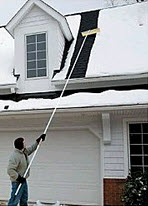A new roof with ice water shield will certainly help keep water out of your house but will not necessarily cure the ice dam.
Maine ice dam roof requirement.
Ice and water protector must reach above the highest expected level of ice dams which will vary by region and the slope of your roof.
The water and wet snow creeps toward the bottom of the roof where it freezes during the nighttime temperature drop.
Eaves flashing is required to prevent ice formation at the eaves and gutter to back up beneath the roof covering.
Ice dam leak protection membrane is required along the eaves of roofs in parts of the united states where ice dams have a history of forming.
In colder regions a good practice is to cover the first 3 feet 36 inches or 0 91 m of roof over heated space with ice and water protector.
If a winter storm that consists mostly of sleet and freezing rain hits your community the sleet can form ice dams on your roof.
On roof slopes of 2 12 to 4 12 the remainder of the roof shall be two layers of 15 felt applied in shingle fashion or 1 layer of ice dam protection.
Once there is a blockage at the bottom of the roof the water and wet snow keeps piling up behind it.
But you can t find a credible company in maine that specializes in ice dam removal and that only uses safe and effective steam to remove ice dams.
Some people will tell you that you need a new roof to fix ice dams.
The majority of ice dam issues we see are due to a lack of insulation or bad ventilation in a given area.
It must be installed the full length of all valleys.
An ice dam is a thick rim of ice that originates along the edges of a roof when snow melts and then refreezes.
On 4 12 or greater slopes the balance of the roof shall be one layer of 15 felt.
During the day the roof heats up and some of the snow melts.
Heat tape is also useful in valleys that gather large amounts of snowfall.
Heat tape is not a permanent solution to ice dam issues on your roof.
You don t need snow.
Ice dams for over time when a roof has not been cleared of snow.
This code implies that ice and water shield eaves flashing is required for installation on all heated steep slope structures exception is unheated structures in colder climates.
Inadequate attic insulation causes ice dams.
The eaves flashing shall be installed from the end of the deck to a minimum of 24 inches up the slope.
Low temperatures for the days preceding the sleet or ice storm combined with low temperatures following the storm make for perfect conditions to create problematic ice dams on your roof.
The minimum is typically 2 feet 24 inches or 0 60 m above the vertical projection of the inside of the exterior wall.
Someone needs to remove that ice dam on your roof before it causes roof leaks or more roof leaks.
Simply plug in the heat tape and snow and ice will slowly melt off your eaves.
Two circumstances combine to make an ice dam.
Ice dams occur when snow melts on sloped roofs and then refreezes again.

